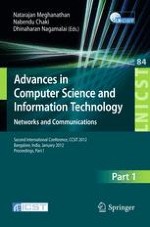2012 | Buch
Advances in Computer Science and Information Technology. Networks and Communications
Second International Conference, CCSIT 2012, Bangalore, India, January 2-4, 2012. Proceedings, Part I
herausgegeben von: Natarajan Meghanathan, Nabendu Chaki, Dhinaharan Nagamalai
Verlag: Springer Berlin Heidelberg
Buchreihe : Lecture Notes of the Institute for Computer Sciences, Social Informatics and Telecommunications Engineering
